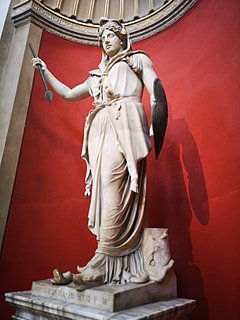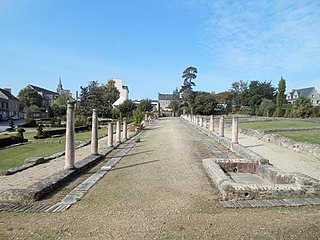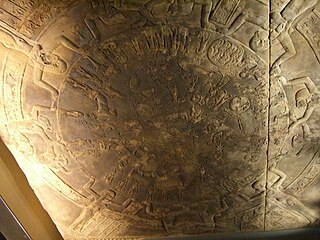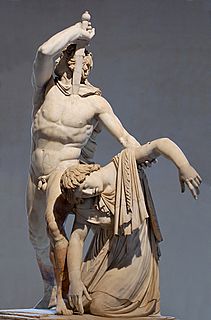The Aedui, Haedui, or Hedui were a Gallic tribe, dwelling in the modern Burgundy region during the La Tène and Roman periods. According to Julius Caesar in his writings on the Gallic Wars in Commentarii de Bello Gallico, the Aedui were one of the stronger gallic tribes, them being the target of jealous tribes like the Helvetii, Sequani, Remi, and Arverni. Furthermore, the Aedui seemed to work in a semi-republican state, with the powerful Vergobret at least slightly being at the will of the people, similar to the senators of Rome

Gaul was a region of Western Europe first described by the Romans. It was inhabited by Celtic tribes, encompassing present day France, Luxembourg, Belgium, most of Switzerland, and parts of Northern Italy, Netherlands, and Germany, particularly the west bank of the Rhine. It covered an area of 494,000 km2 (191,000 sq mi). According to Julius Caesar, Gaul was divided into three parts: Gallia Celtica, Belgica, and Aquitania. Archaeologically, the Gauls were bearers of the La Tène culture, which extended across all of Gaul, as well as east to Raetia, Noricum, Pannonia, and southwestern Germania during the 5th to 1st centuries BC. During the 2nd and 1st centuries BC, Gaul fell under Roman rule: Gallia Cisalpina was conquered in 203 BC and Gallia Narbonensis in 123 BC. Gaul was invaded after 120 BC by the Cimbri and the Teutons, who were in turn defeated by the Romans by 103 BC. Julius Caesar finally subdued the remaining parts of Gaul in his campaigns of 58 to 51 BC.

Venus is a Roman goddess, whose functions encompassed love, beauty, desire, sex, fertility, prosperity and victory. In Roman mythology, she was the ancestor of the Roman people through her son, Aeneas, who survived the fall of Troy and fled to Italy. Julius Caesar claimed her as his ancestor. Venus was central to many religious festivals, and was revered in Roman religion under numerous cult titles.

Salamis is an ancient Greek city-state on the east coast of Cyprus, at the mouth of the river Pedieos, 6 km north of modern Famagusta. According to tradition, the founder of Salamis was Teucer, son of Telamon, who could not return home after the Trojan war because he had failed to avenge his brother Ajax.

Empúries was an ancient city on the Mediterranean coast of Catalonia, Spain. Empúries is also known by its Spanish name, Ampurias. The city Ἐμπόριον was founded in 575 BC by Greek colonists from Phocaea. After the invasion of Gaul from Iberia by Hannibal the Carthaginian general in 218 BC, the city was occupied by the Romans. In the Early Middle Ages, the city's exposed coastal position left it open to marauders and it was abandoned.

The Palatine Hill, which is the centremost of the Seven Hills of Rome, is one of the most ancient parts of the city and has been called "the first nucleus of the Roman Empire." The site is now mainly a large open-air museum while the Palatine Museum houses many finds from the excavations here and from other ancient Italian sites.

Byblos is the largest city in the Mount Lebanon Governorate of Lebanon. It is believed to have been first occupied between 8800 and 7000 BC and continuously inhabited since 5000 BC, making it one of the oldest continuously inhabited cities in the world. It is a UNESCO World Heritage Site.

Olympia is a small town in Elis on the Peloponnese peninsula in Greece, famous for the nearby archaeological site of the same name, which was a major Panhellenic religious sanctuary of ancient Greece, where the ancient Olympic Games were held. The site was primarily dedicated to Zeus and drew visitors from all over the Greek world as one of a group of such "Panhellenic" centres which helped to build the identity of the ancient Greeks as a nation. Despite the name, it is nowhere near Mount Olympus in northern Greece, where the Twelve Olympians, the major deities of Ancient Greek religion, were believed to live.
The King of Tyre was the ruler of Tyre, the ancient Phoenician city in what is now Lebanon.
This is a timeline of architecture, indexing the individual year in architecture pages. Notable events in architecture and related disciplines including structural engineering, landscape architecture, and city planning. One significant architectural achievement is listed for each year.

Juno is an ancient Roman goddess, the protector and special counselor of the state. A daughter of Saturn, she is the wife of Jupiter and the mother of Mars, Vulcan, Bellona and Juventas. She is the Roman equivalent of Hera, queen of the gods in Greek mythology; like Hera, her sacred animal was the peacock. Her Etruscan counterpart was Uni, and she was said to also watch over the women of Rome. As the patron goddess of Rome and the Roman Empire, Juno was called Regina ("Queen") and was a member of the Capitoline Triad, centered on the Capitoline Hill in Rome; it consisted of her, Jupiter, and Minerva, goddess of wisdom.
Roman Gaul refers to Gaul under provincial rule in the Roman Empire from the 1st century BC to the 5th century AD.

Satricum, an ancient town of Latium vetus, lay on the right bank of the Astura river some 60 kilometres (37 mi) SE of Rome in a low-lying region south of the Alban Hills, at the NW border of the Pontine Marshes. It was directly accessible from Rome via a road running roughly parallel to the Via Appia.

The Temple of Jupiter Stator was a temple of Ancient Rome in the southern Campus Martius. It was destroyed in 64 AD in the Great Fire of Rome.

Alba-la-Romaine is a commune in the Ardèche department in the Auvergne-Rhône-Alpes region of southern France.

Corseul is a commune in the Côtes-d'Armor department of Brittany in northwestern France.

The sculptured Dendera zodiac is a widely known Egyptian bas-relief from the ceiling of the pronaos of a chapel dedicated to Osiris in the Hathor temple at Dendera, containing images of Taurus and Libra. This chapel was begun in the late Ptolemaic period; its pronaos was added by the emperor Tiberius. This led Jean-François Champollion to date the relief to the Greco-Roman period, but most of his contemporaries believed it to be of the New Kingdom. The relief, which John H. Rogers characterised as "the only complete map that we have of an ancient sky", has been conjectured to represent the basis on which later astronomy systems were based. It is now on display at the Musée du Louvre, Paris.

The Gauls were a group of Celtic peoples of Continental Europe in the Iron Age and the Roman period. The area they originally inhabited was known as Gaul. Their Gaulish language forms the main branch of the Continental Celtic languages.

The Altar of Domitius Ahenobarbus, more properly called the Statuary group base of Domitius Ahenobarbus, is a series of four sculpted marble plaques which probably decorated a base which supported cult statues in the cella of a Temple of Neptune located in Rome on the Field of Mars.

Tiddis was a Roman city that depended on Cirta and a bishopric as Tiddi, which remains a Latin Catholic titular see.















